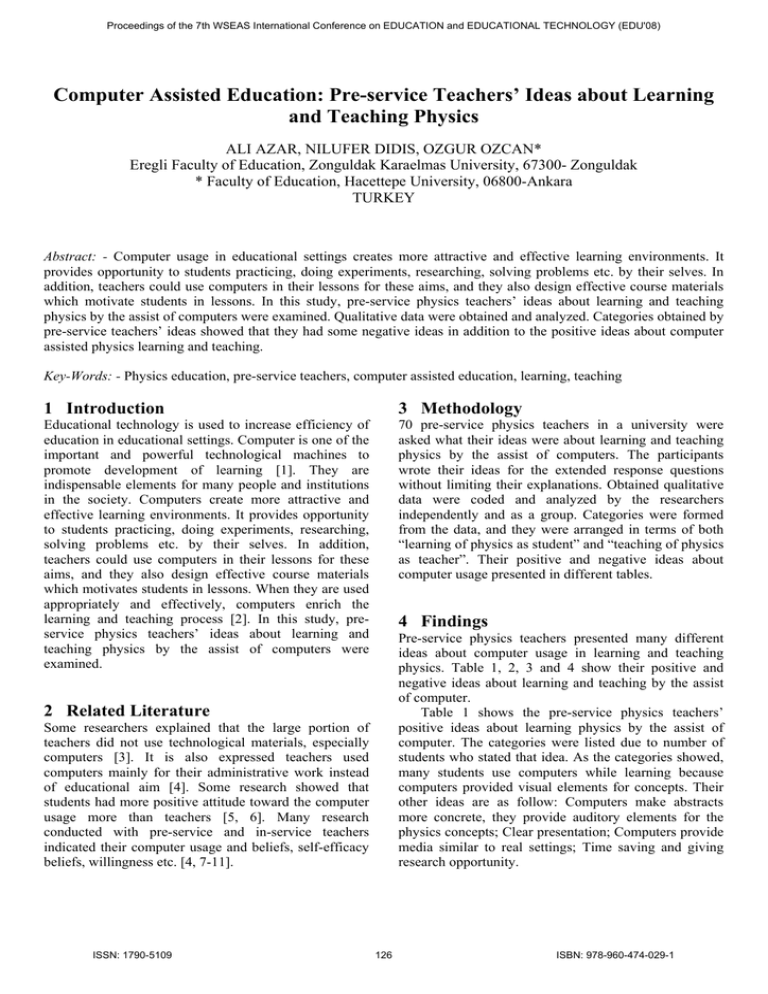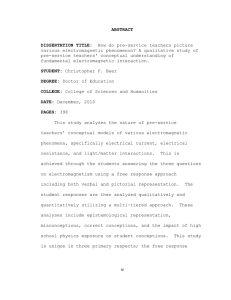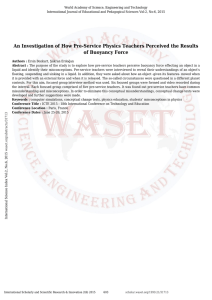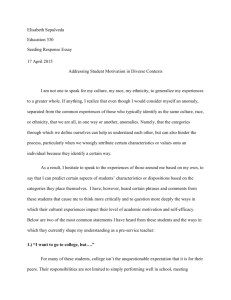Computer Assisted Education: Pre-service Teachers` Ideas
advertisement

Proceedings of the 7th WSEAS International Conference on EDUCATION and EDUCATIONAL TECHNOLOGY (EDU'08) Computer Assisted Education: Pre-service Teachers’ Ideas about Learning and Teaching Physics ALI AZAR, NILUFER DIDIS, OZGUR OZCAN* Eregli Faculty of Education, Zonguldak Karaelmas University, 67300- Zonguldak * Faculty of Education, Hacettepe University, 06800-Ankara TURKEY Abstract: - Computer usage in educational settings creates more attractive and effective learning environments. It provides opportunity to students practicing, doing experiments, researching, solving problems etc. by their selves. In addition, teachers could use computers in their lessons for these aims, and they also design effective course materials which motivate students in lessons. In this study, pre-service physics teachers’ ideas about learning and teaching physics by the assist of computers were examined. Qualitative data were obtained and analyzed. Categories obtained by pre-service teachers’ ideas showed that they had some negative ideas in addition to the positive ideas about computer assisted physics learning and teaching. Key-Words: - Physics education, pre-service teachers, computer assisted education, learning, teaching 1 Introduction 3 Methodology Educational technology is used to increase efficiency of education in educational settings. Computer is one of the important and powerful technological machines to promote development of learning [1]. They are indispensable elements for many people and institutions in the society. Computers create more attractive and effective learning environments. It provides opportunity to students practicing, doing experiments, researching, solving problems etc. by their selves. In addition, teachers could use computers in their lessons for these aims, and they also design effective course materials which motivates students in lessons. When they are used appropriately and effectively, computers enrich the learning and teaching process [2]. In this study, preservice physics teachers’ ideas about learning and teaching physics by the assist of computers were examined. 70 pre-service physics teachers in a university were asked what their ideas were about learning and teaching physics by the assist of computers. The participants wrote their ideas for the extended response questions without limiting their explanations. Obtained qualitative data were coded and analyzed by the researchers independently and as a group. Categories were formed from the data, and they were arranged in terms of both “learning of physics as student” and “teaching of physics as teacher”. Their positive and negative ideas about computer usage presented in different tables. 4 Findings Pre-service physics teachers presented many different ideas about computer usage in learning and teaching physics. Table 1, 2, 3 and 4 show their positive and negative ideas about learning and teaching by the assist of computer. Table 1 shows the pre-service physics teachers’ positive ideas about learning physics by the assist of computer. The categories were listed due to number of students who stated that idea. As the categories showed, many students use computers while learning because computers provided visual elements for concepts. Their other ideas are as follow: Computers make abstracts more concrete, they provide auditory elements for the physics concepts; Clear presentation; Computers provide media similar to real settings; Time saving and giving research opportunity. 2 Related Literature Some researchers explained that the large portion of teachers did not use technological materials, especially computers [3]. It is also expressed teachers used computers mainly for their administrative work instead of educational aim [4]. Some research showed that students had more positive attitude toward the computer usage more than teachers [5, 6]. Many research conducted with pre-service and in-service teachers indicated their computer usage and beliefs, self-efficacy beliefs, willingness etc. [4, 7-11]. ISSN: 1790-5109 126 ISBN: 978-960-474-029-1 Proceedings of the 7th WSEAS International Conference on EDUCATION and EDUCATIONAL TECHNOLOGY (EDU'08) 8. Insufficiency of computers 9. Imagination/thinking 10. Boring 11. Searching in books 12. Difficult to gain attention 13. Problem solving 14. Studying with paper-pen/ by writing Table 3. Pre-service physics teachers’ negative ideas about learning physics by the assist of computer LEARNING (Positive ideas) 1. Provides visual elements for concepts (photograph, animation, simulation etc.) 2. Making abstracts more concrete 3. Provides auditory elements for concepts (video) 4. Clarity 5. Providing media similar to real settings 6. Time saving 7. Research (internet, electronic media etc.) Table 1. Pre-service physics teachers’ positive ideas about learning physics by the assist of computer Table 4 presents also some negative ideas. Most of the students think same as in the learning dimension. The other mostly explained statement is “insufficiency of computers”. They clarified this statement by indication of impossibility of teaching some concepts with computers. Their explanations include insufficiency of visual and auditory materials, difficulty of preparing instructional materials etc. As it is similar with learning dimension, they also had ideas about teaching as they have learned. In other words, they indicated the importance of step-by-step teacher explanation and faceto-face interaction. Table 2 indicates that the pre-service physics teachers’ positive ideas about teaching physics by the assist of computer. Teacher candidates explained some new statements which are different from “learning” dimension. They stated computers were important for gaining attention and motivation. In addition, they explained computers improved the creativity of students. TEACHING (Positive ideas) 1. Provides visual elements for concepts (photograph, animation, simulation etc.) 2. Important for motivation/gaining attention 3. Making abstracts more concrete 4. Improve creativity 5. Clarity Table 2. Pre-service physics teachers’ positive ideas about teaching physics by the assist of computer TEACHING (Negative ideas) 1. Observation and experimentation (by touching) 2. Insufficiency of computers 3. Teacher explanation (step-by-step) 4. Teacher-student interaction (face-to-face) 5. Discussion 6. Searching in books 7. Encourage lazzyness 8. No need Table 4. Pre-service physics teachers’ negative ideas about teaching physics by the assist of computer Pre-service physics teachers’ positive ideas about learning and teaching are almost in the same percentages (~35%). In addition to their explanations, teacher candidates indicated computers should be used carefully and effectively. Rest of 70 pre-service teachers, (~65%), have some negative ideas about learning and teaching physics by the assist of computers. As it is seen in Table 3, most of the students indicated physics was learned by real experimental processes such as stating hypothesis, observation, getting data etc. Many of them also stated they need teacher’s step by step explanation. In addition, they added the importance of teacher-student interaction in learning of physics. 5 Conclusion Pre-service physics teachers stated their ideas about computer assisted physics learning and teaching. Although the positive ideas have smaller percentage than the negative ones, the percentages of statements about learning and teaching are similar. The smaller percentage of the positive ideas may be result from being familiar with traditional, teacher centered, direct teaching in their lives. One of the interesting statements is explanation of some teacher candidates as computers are important for gaining attention and motivation (similar with the findings of ref. 3), however, some of them think that it would be difficult to gain attention while learning by the help of computers. Identification of the ideas of teacher candidates is important to facilitate their computer usage in lessons, because many of them tend to use only for administrative work [4]. By considering their positive LEARNING (Negative ideas) 1. Observation and experimentation (by touching) 2. Teacher explanation (step-by- step) 3. Teacher-student interaction (face-to-face) 4. Asking question 5. Discussion 6. Difficult to apply (technical) 7. Encourage lazzyness ISSN: 1790-5109 127 ISBN: 978-960-474-029-1 Proceedings of the 7th WSEAS International Conference on EDUCATION and EDUCATIONAL TECHNOLOGY (EDU'08) [11] MacArthur, C. A., & Malouf, D. B., Teachers’ Beliefs, Plans and Decisions about ComputerBased Instruction, The Journal of Special Education, Vol.25, No.5, 1991, pp. 44-72 and negative ideas, computer assisted instruction should be explained as a methodology in detail in methods of teaching courses, and some applications should be done in teacher –training periods. The teachers should educate the individuals who could use new technologies and make scientific decisions. In addition, opportunities to be engaging with computers should be given to teacher candidates. In all science lessons, technologic materials should be used and the learning levels of students should be increased by this way. References: [1] Dyer, C. A. Preparing for Computer Assisted Instruction, New Jersey: Educational Technology Publications, 1972 [2] Akkoyunlu, B., Bilgi Teknolojilerinin Okullarda Kullanimi ve Ogretmenlerin rolu, Hacettepe Universitesi Egitim Fakultesi Dergisi, Vol.11, 1995, pp. 105-109 [3] Cagiltay, K., Cakiroglu, J., Cagiltay, N., & Cakiroglu, E., Ogretimde Bilgisayar Kullanimina Iliskin Ogretmen Gorusleri, Hacettepe Universitesi Egitim Fakultesi Dergisi, Vol.21, 2001, pp. 19-28 [4] McCannon, M., & Crews, B. T., Assessing the Technology Training Needs of Elementary School Teachers, Journal of Technology and Teacher Education, Vol. 8, No.2, 2000, pp. 111-121 [5] McInerney, V., McInerney, D. M., & Sinclair, K. E., Student Teachers, Computer Anxiety and Computer Experience, Journal of Educational Computing Research, Vol.11, No.1, 1994, pp. 27-50 [6] Davidson, G. V., Savenye, W. C., & Orr, K. B., How do Learning Styles Relate to Performance in a Computer Applications Course? Journal of Research on Computing in Education, Vol.24, 1992, pp. 348-358 [7] Askar, P., & Umay, A., Ilkogretim Matematik Ogretmenligi Ogretmen Adaylarınin Bilgisayarla Ilgili Ozyeterlilik Algisi, Hacettepe Universitesi Egitim Fakultesi Dergisi, Vol.21, 2001, pp. 1-8 [8] Delcourt, M., & Kinzie, M., Computer Technologies in Teacher Education: The Measurement of Attitudes and Self-efficacy, Journal of Research and Development in Education, Vol.27, 1993, pp. 31-37 [9] Dusick, D. M., & Yıldırım, I. S., Faculty Computer Use and Training Needs: Identifying Distinct Needs for Different Populations, Community College Review, Vol.27, No.4, 2000, pp. 33-48 [10] Forgasz, H., Teachers and Pre-service Teachers Gendered Beliefs: Students and Computers, Paper presented at ICME-10, Copenhagen, 2004 ISSN: 1790-5109 128 ISBN: 978-960-474-029-1



